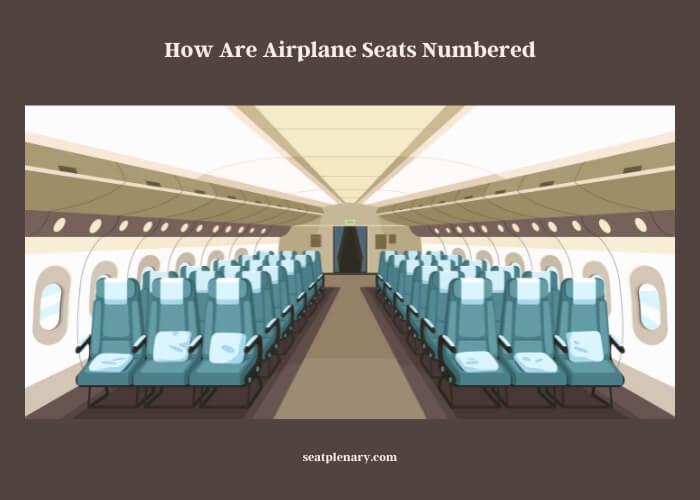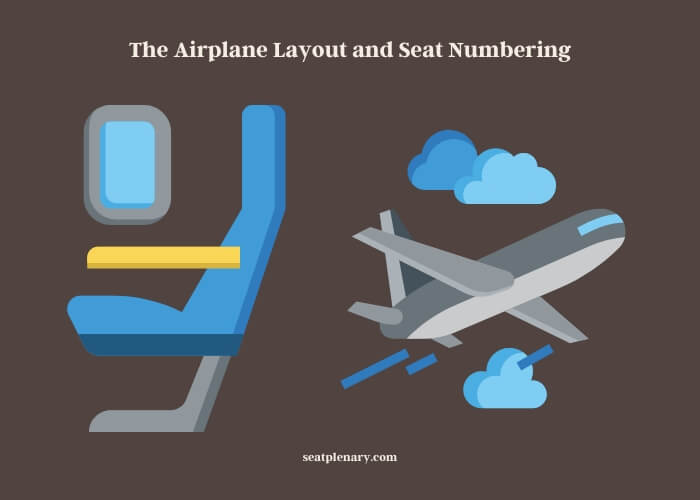Airplane seats are labeled using a combination of numbers and letters. The number corresponds to the row you’re assigned, and the letter pinpoints your specific seat within that row. This system is in place on commercial jets to avoid confusion between row and seat numbers.
The organization of seats in an aircraft is governed by a careful arrangement known as the aircraft layout. This layout comprises not just seats but also cabin classes, ranging from economy to business and first-class, each offering different degrees of in-flight comfort. In addition, airlines follow specific policies for seat numbering and row identification, ensuring a coherent mapping for passengers and crew alike.

This coordination is crucial for an orderly boarding process. As passengers present their boarding passes at the gate, the ticketing system feeds information about each passenger’s seat number. This aids in evenly distributing passengers across the aircraft, ensuring stability and efficiency in flight.
The seat map, a critical element in the entire process, provides a visual representation of the aircraft’s seating arrangement. It assists passengers in locating their seats and helps airlines manage passenger distribution effectively. This entire system works in unison to provide an efficient and comfortable travel experience for all passengers on board.
The Story of Airplane Seat Numbering
Pioneers of Seat Numbering: A Historical Overview
Airplane seat numbering came into existence with the growth of commercial aviation. In the early days, seating arrangements were less formal, with passengers merely choosing any available seat. As air travel gained popularity, there arose a need for a systematic approach to seating.
The Evolution of Numbering Practices
The original approach of “free seating” gradually gave way to an organized seating system. Over the years, airlines have tweaked and modified their seat numbering practices, aiming for utmost efficiency and passenger convenience.
Principles Behind Seat Numbering
Anatomy of a Seat Number: Rows and Letters
Airplane seat numbers usually consist of a row number and a seat letter. The row number tells you the specific row where your seat is located. The seat letter, on the other hand, denotes your exact position within that row.
Where is Seat D Located on an Airplane?
Seat is d on a plane. Seat D is typically located in the middle section of the aircraft, between seats C and E. Its exact location can vary depending on the airplane model and seating configuration. Passengers seated in this row may enjoy a relatively calm flight experience, away from the noise near the galley or lavatories.
Variances in Seat Numbering: Airlines and Airplanes
While the basic principles of seat numbering remain constant across the industry, there can be minor variations. These discrepancies are often attributed to different airplane models or individual airline policies.
Comparative Analysis of Seat Numbering Systems Across Different Airlines
| Airline | Aircraft Model | First Class | Economy Class |
| Airline A | Boeing 777 | 1A – 4F | 5A – 49F |
| Airline B | Airbus A330 | 1A – 4K | 5A – 55K |
| Airline C | Boeing 737 | No First Class | 1A – 29F |
Seat Classifications and Their Numbering
First Class: The Elite Rows
First class usually occupies the front rows of an airplane. It starts from row number one and may extend up to four or five rows, depending on the aircraft model.
Business Class: Corporate Convenience
Immediately behind the first class, you’ll find the business class seats. The numbering follows a consecutive pattern, continuing from where the first-class numbering ends.
Economy Class: The Heart of the Aircraft
Economy class is where the majority of travelers are seated. It usually begins after business class and extends to the end of the aircraft. Rows are numbered consecutively, and letters are used to identify individual seats within the rows.
Typical Seat Numbering Patterns in Different Seat Classes
| Seat Class | Typical Row Numbers |
| First Class | 1 – 5 |
| Business Class | 6 – 10 |
| Economy Class | 11 – end of aircraft |
The Intricacies of the Lettering System
The Importance of Each Seat Letter
Seat letters are crucial in the seat numbering system. They help passengers find their specific seats within a row. Generally, the letter ‘A’ represents the window seat on the left side of the plane (when facing forward), with other letters representing middle and aisle seats.
The Curious Case of Missing Letters
Ever noticed how some letters are missing in the seat numbering system? For instance, ‘I’ is often omitted due to its visual similarity to ‘1’. The objective is to avoid confusion during the boarding process.
Boarding Procedures and Seat Numbers
Sequence of Boarding: Role of Seat Numbers
Seat numbers play a critical role in streamlining the boarding process. Many airlines board passengers based on their row numbers, starting from the back to minimize congestion in the aisles.
Efficient Boarding: Seat Numbers to the Rescue
Not only do seat numbers help passengers find their spots, but they also assist cabin crew in managing the boarding procedure. An organized boarding process ensures a timely departure and contributes to overall passenger satisfaction.
The Airplane Layout and Seat Numbering
Airplane Seat Maps: A Closer Look
Airplane seat maps are handy tools that depict the seating configuration of a specific aircraft model. They illustrate how rows and seats are arranged, providing passengers with a visual guide to their seat location.

The Connection Between Layouts and Seat Numbering
The seating layout significantly influences the seat numbering system. Factors such as the number of aisles, the arrangement of seats (2-2, 3-3, 2-3-2, etc.), and the location of the emergency exits all impact how seats are numbered.
Examples of Airplane Seat Layouts and Corresponding Numbering Systems
| Aircraft Model | Seat Layout | Example Seat Numbers |
| Boeing 777 | 3-4-3 | 20A, 20B, 20C, 20H, 20J, 20K |
| Airbus A330 | 2-4-2 | 30A, 30B, 30G, 30H |
| Boeing 737 | 3-3 | 15A, 15B, 15C, 15D, 15E, 15F |
Unique Seats and Their Numbering
Exit Row Seats: Safety and Comfort Considerations
Exit row seats are typically numbered as per their corresponding row, but they are often in high demand due to the extra legroom they offer. Passengers seated in these rows are expected to assist in the event of an emergency evacuation, subject to certain regulations.
Bulkhead Seats: Space and Convenience
Bulkhead seats are the ones located immediately behind the physical partitions (bulkheads) in an airplane. These seats provide passengers with extra legroom and are popular among travelers, despite having no under-seat storage space. They follow the conventional seat numbering system.
Reading Your Boarding Pass
Deciphering Your Seat Number
Finding your seat number on a boarding pass is quite straightforward. It is usually printed next to your flight information. This number is the key to your designated seat on the plane.
Relevant Information You Should Know
Besides your seat number, your boarding pass contains other vital information such as your flight number, departure time, boarding gate, and barcode for security checks. Knowing how to read this information can make your travel experience smoother.
The Future of Airplane Seat Numbering
Technological Trends Affecting Seat Numbering
The world of air travel is ever-evolving, and so are the methods of seat numbering. Emerging technologies like digital boarding passes and personalized seat selection may redefine how we perceive the seat numbering system.
Predictions and Expectations for the Coming Years
While it’s challenging to predict exact changes, the trend towards personalization and convenience is apparent. In the coming years, we might witness an even more passenger-friendly and intuitive seat numbering system.
What is the Seat Numbering System on Alaska Airlines?
The seat details for 19E on Alaska Airlines may vary based on the aircraft type. However, generally, the seat numbering system follows a standard pattern. Seat numbers on Alaska Airlines begin with “1” at the front and increase towards the rear of the cabin, with the letters A, B, C for the left side and D, E, F for the right side. This system helps passengers locate their assigned seats easily during boarding.
Why Are Some Airplane Seats Designated as Emergency Exits?
Some airplane seats are designated as emergency exits to ensure compliance with safety guidelines for teenagers and all passengers. These seats are strategically located to facilitate a quick and easy evacuation in the event of an emergency. Passengers sitting in these seats are responsible for helping others exit safely if necessary.
Summary
Major Takeaways on Airplane Seat Numbering
Airplane seat numbering is a well-structured system designed for efficiency and convenience. From aiding in a smooth boarding process to guiding passengers to their specific seats, the numbering system forms an integral part of air travel.
Recap: Why Seat Numbering Matters
Knowing how airplane seats are numbered allows for a hassle-free travel experience. It aids in seat selection, assists in navigation onboard the aircraft, and contributes to the overall management of passenger movement. So, next time you fly, you’ll appreciate the simplicity and logic behind the numbers and letters on your boarding pass.
References
- Smith, P. (2013). Airplane Seating Guide: What to Know Before You Go. Retrieved from Airfare Watch Dog
- Federal Aviation Administration. (2019). Airplane Seating and Safety Regulations. Retrieved from FAA.gov
Related Post:
- All About Laying Across Airplane Seats for Your Comfort
- Air Travel at Size 24: Tips for Comfortable Seating Onboard
- Air France Preferred Seat vs Economy: Which One Should You Choose?
- Where is Seat A on a Plane: An Insightful Flight Seating Guide
- Is Seat F on a Plane a Window Seat
- Does the Beis Mini Weekender Fit Under a Plane Seat?
- Does Doona Fit in Airplane Seat? – A Compatibility Guide
